Building your brand is crucial to growing a business and it must be done continuously for as long as a company is in operation. With the pandemic, consumer decision-making barriers and uncertainty about the market environment rose, thereby making brand building even more crucial. With so many businesses and competitors in China, it is essential to understand the effective way of advertising in China to stand out in the market.
Consumers’ decision-making process and the purpose of advertisements
In the digital age, there is an abundance of brands and information. Moreover, information channels are becoming increasingly fragmented. Consequently, it is becoming harder for advertisements to pique the consumer’s interest and produce the desired effect: sales conversion.
We can observe a significant increase in “active contact with information”, a situation where people actively seek out more information regarding a product, service, or advertisement and share it with others. Two unique behaviors from consumers have become important factors in the purchase decision: searching and sharing. Therefore, we can apply AISAS (Attention, Interest, Search, Action, Share) model to understand consumers’ psychological stages to maximize the impact of advertisements.
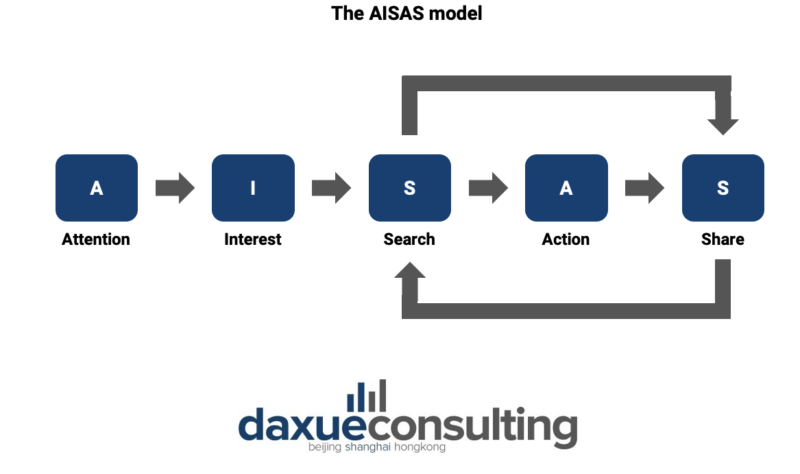
The power of advertisement
Advertising delivers unique value and significance for brands. Entrepreneurs can convey their brand values to consumers and develop a unique brand image through advertising, as well as connect a brand’s image to the emotional attribute displayed in the commercials. Thus, influencing consumers’ perception of their brand.
Additionally, advertisements aid in providing consumers with knowledge regarding brand’s products or services. This information assists prospective consumers in recognizing the products, hence lowering decision-making costs, and easing transactions.

China’s advertisement spending is increasing at a CAGR of 8.84%
The advertising industry in China is a billion-dollar business. The country is the world’s second-largest ad market right after the United States. In 2023, it is estimated that China would spend US$223.93 billion on ads. TV & Video Advertising is the market’s largest category, with a market value of US$72.32 billion in 2023.

In China’s advertising industry, 89% of total ad spending is predicted to come from digital advertising in 2023. Digital advertising will also grow to US$291.8 billion, accounting for 93% of the total spending in the industry. Outdoor and online advertising have thrived despite the continued decline of traditional print and broadcast media. Rapid technical innovation and China’s mobile-savvy population are the key drivers of the expansion.
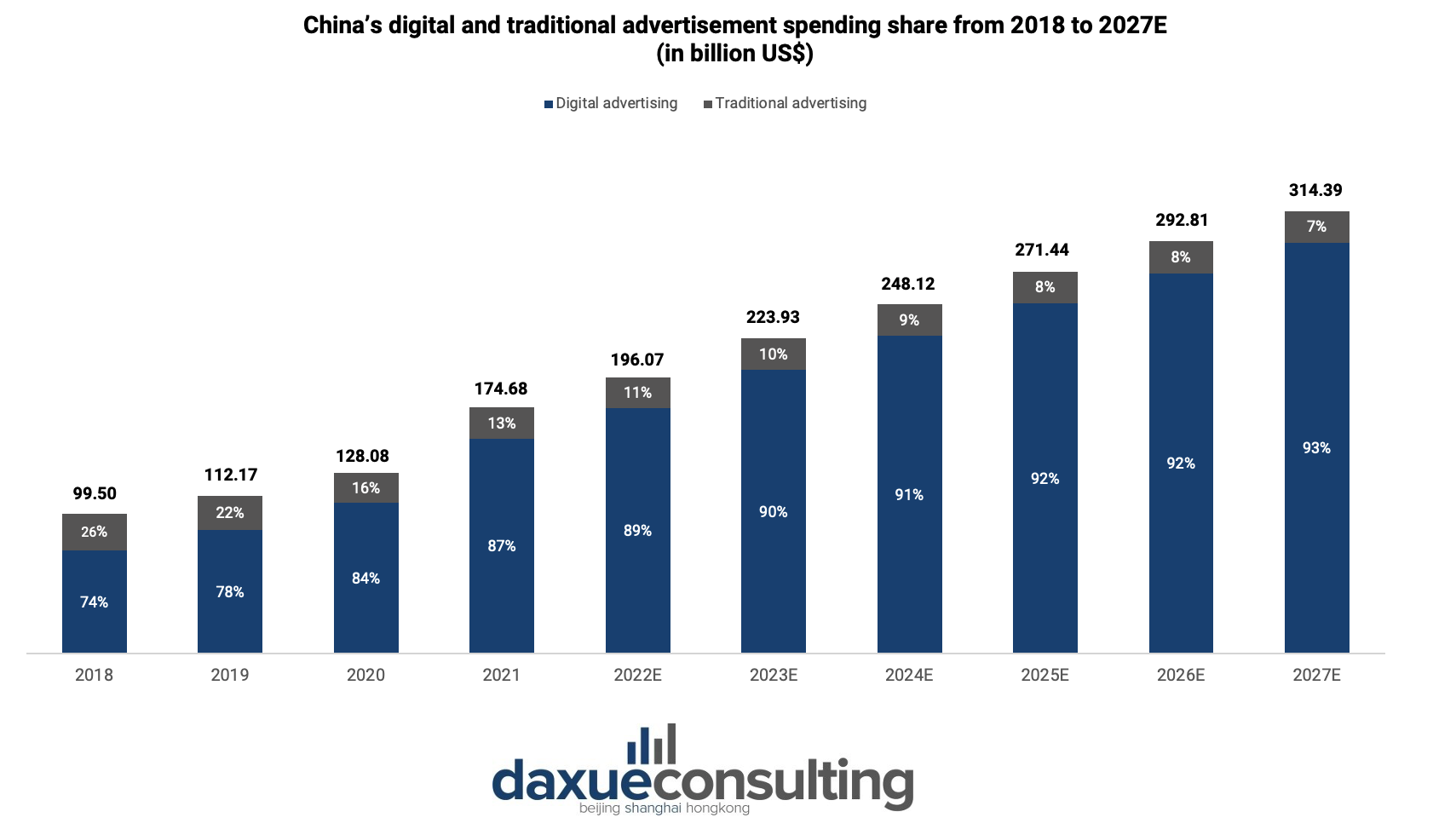
The historical development of advertising in China
Before 2006, content distribution channels were relatively simple. Starting from 2006 until 2012, PC devices’ penetration rate increased. Until 2012, cable TV advertisements were popular as they covered a wide range of users and had a substantial impact. Outdoor advertisements also started popping up.
Between 2012 to 2016, smartphones grew rapidly. Over-the-top (OTT) television and high-speed rail outdoor advertisements began to appear. The use of trackable and quantifiable advertising formats such as pop-up ads, search ads, and others became widespread among advertisers.
From 2016 until today, mobile internet traffic increased significantly. Outdoor advertising started to utilize sensorimotor interaction, augmented reality, and other technologies. Additionally, the PC advertising model keeps on evolving towards a path that is more brand-focused. Information flow advertisements and other new formats have emerged, and data mining and interoperability received increased focus.
The impact of technology on advertising in China
The focus of branding is shifting from merely grabbing attention to relationship-building. Consumers formerly had only one channel available for information delivery. With the advancement of technology, advertising in China has shifted from one-way communication to two-way interaction.
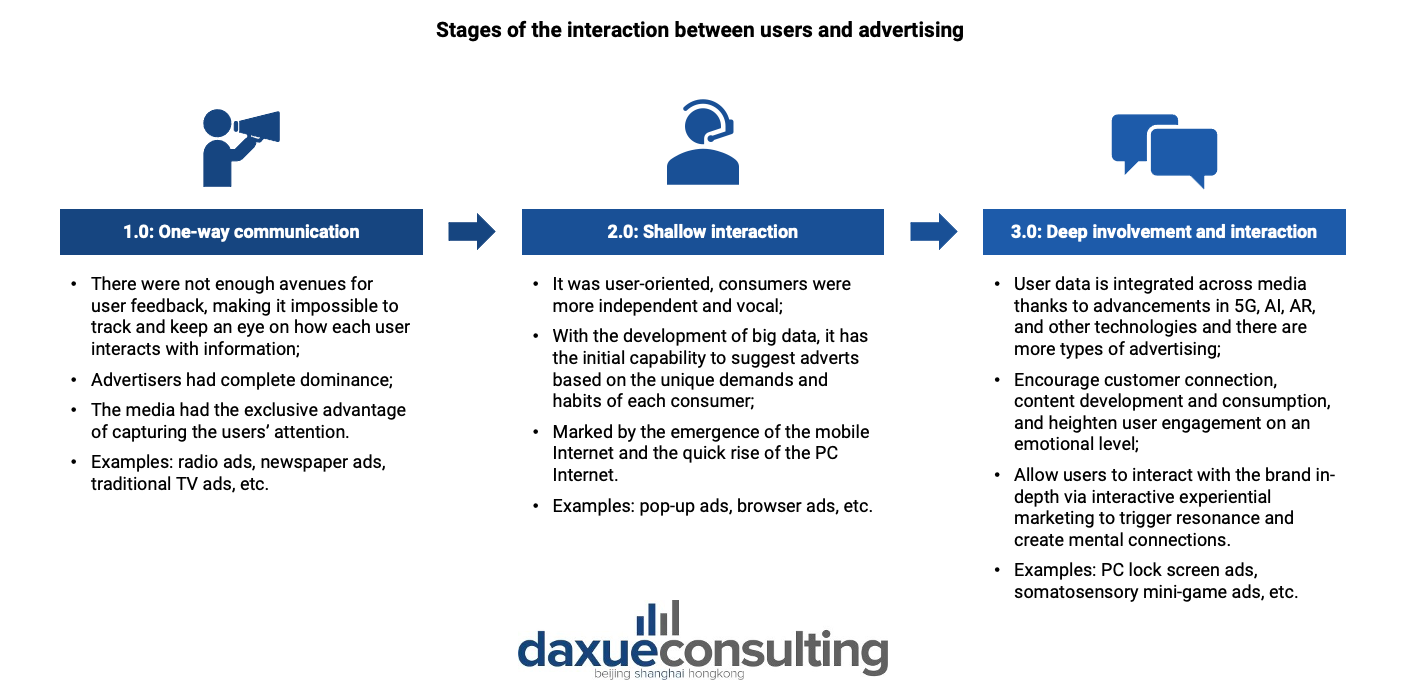
Understanding “scenarios” and choosing the right ad placements is crucial to generate the desired impact
People are exposed to a variety of “scenarios” every day, and typically each “scenario” would have its own usual media formats. These media forms vary as consumers have different states, moods, and concerns in different “scenarios”. As a result, individuals are more likely to have a greater need for particular services and goods in a certain “scenario”.
The comprehensive use of different touchpoints in various “scenarios” can enable businesses to infiltrate customers’ daily lives and covertly implant the brand’s image in their thoughts, thereby influencing consumers.
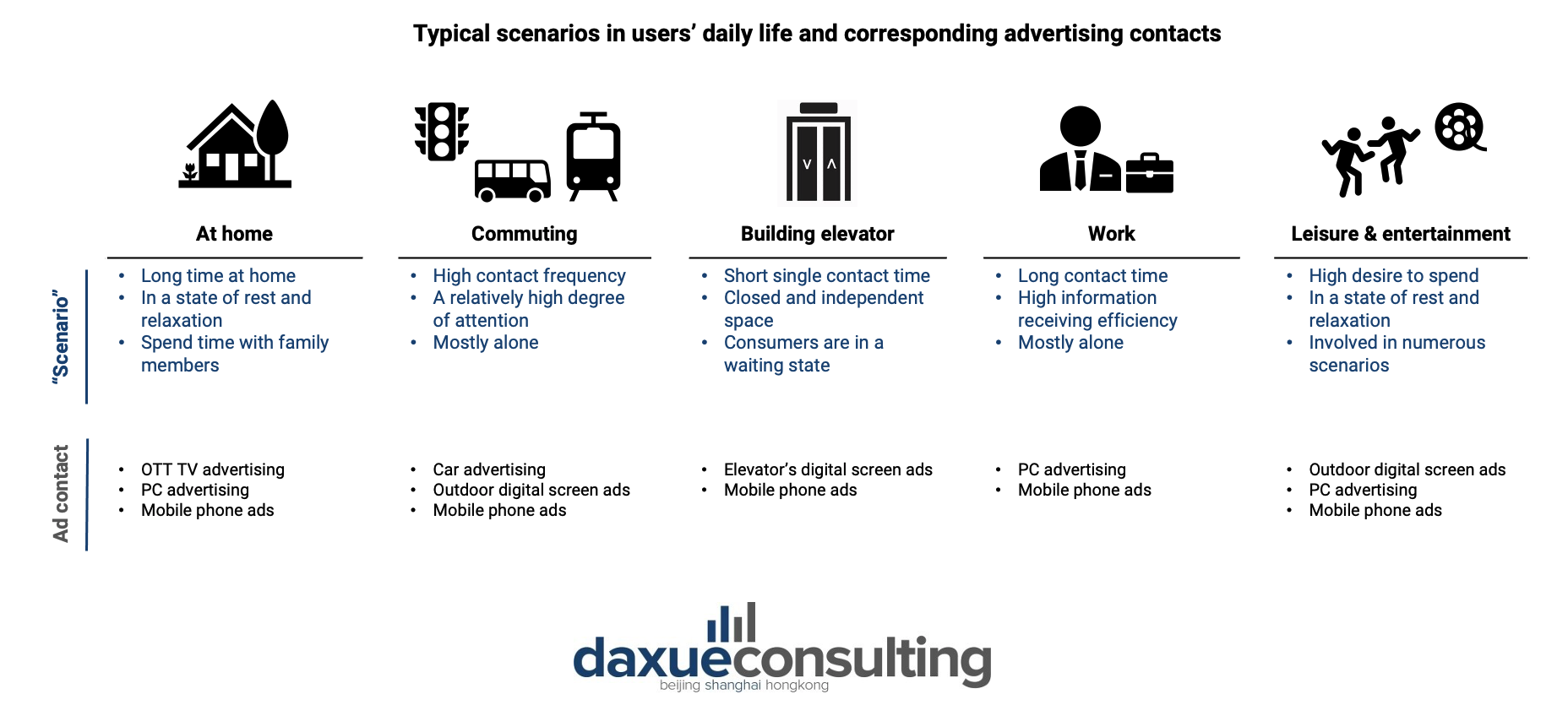
Advertisement screens can generally be categorized into four
Outdoor digital screens
Digital media in a public setting is referred to by the term “outdoor digital screens”. Outdoor digital screens are ubiquitous in contemporary urban life and cover a wide variety of content. Outdoor digital screen media includes everything from massive digital billboards to screens in movie theaters. Outdoor digital screens are closely associated with users’ urban mobility.
Chinese people usually bump into such kind of screens in scenarios related to travel (as bus stations, subway stations, vehicle screens, etc.), building elevators (residential, office buildings, etc.), leisure and entertainment (shopping malls, cinemas, etc.), and off-site travel (airports, railway stations, highway signs, etc.).
The effectiveness of outdoor digital screens in brand promotion and communication is ensured by a comparatively high touch frequency per day (3-5 times), allowing commercials to subtly sway consumers’ opinions. However, 31.8% of people only saw those commercials for a total of 1-3 minutes. Therefore, brands must produce an ad that can capture the consumers’ interest within that period.
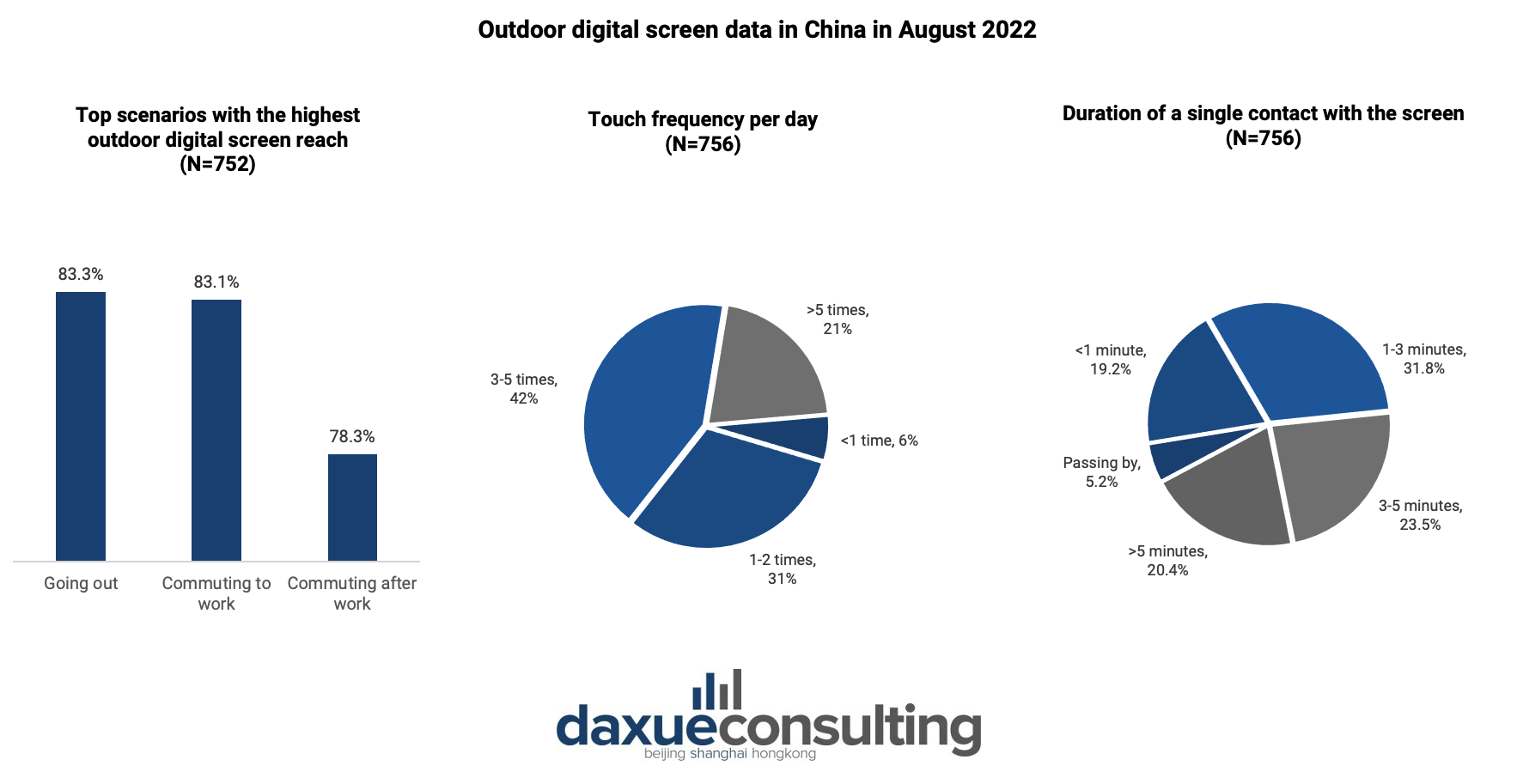
OTT screens
As previously mentioned, OTT stands for “over-the-top”. It infers that a content provider is going “over the top” of existing internet access. OTT is a term used to describe any type of streaming media content delivered over the internet.
The time when OTT screens can reach users is relatively concentrated: after dinner and at night before going to bed. People typically use OTT screens for leisure and pleasure, such as watching movies, TV shows, and other programs that are available on demand, as well as for gaming and web browsing.
Most users only touch OTT screens 1-2 times per day, which is less frequent when compared to outdoor digital screens. However, 49.3% of consumers spend 1-3 hours on a single interaction with OTT screens. A longer period of interaction gives brands more room to promote their goods and services.
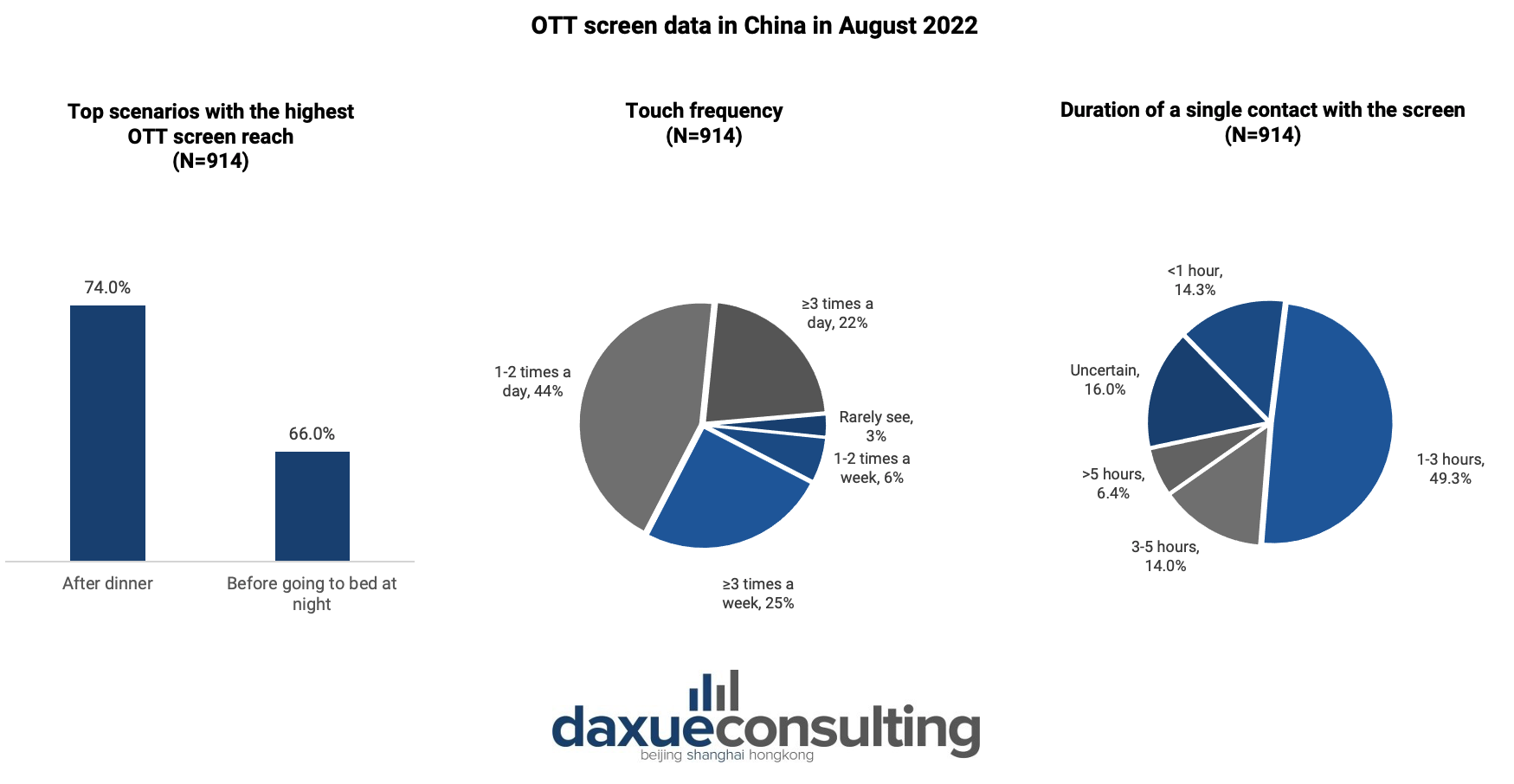
PC screens
PCs are currently most frequently used for leisure and as productivity tools for work and school. In China, 58% of people use a PC more than three times every day, which is a high usage rate. Their contact with a PC screen is also very lengthy, with 48% claiming that they use it for more than 5 hours per day. As PC screens occupy users’ daily attention for a long period of time, brands can utilize the value behind PC advertising.
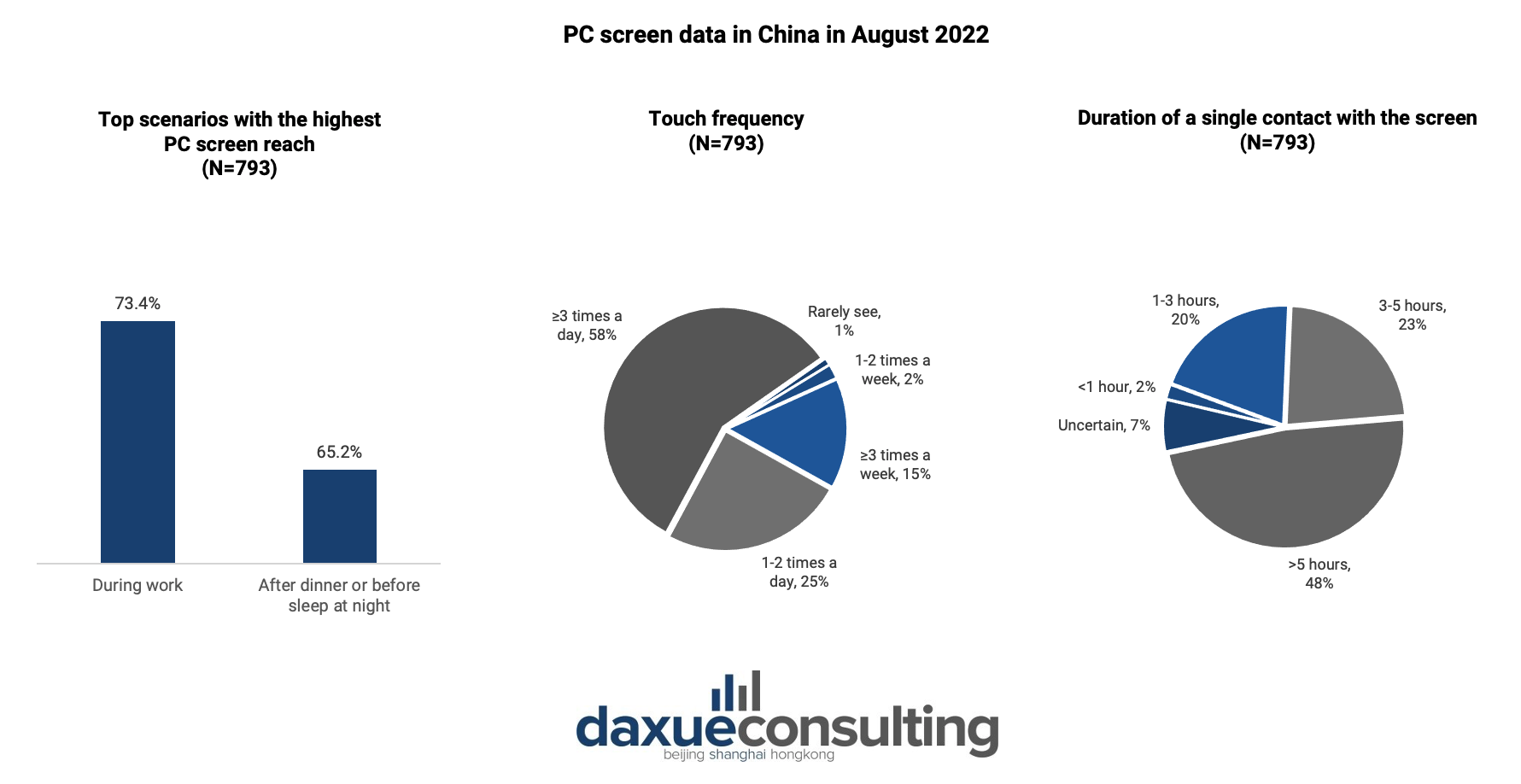
Mobile phone screens
The mobile phone combines a number of tasks, including social interaction, audio-visual entertainment, and other services. From viewing adverts to making purchases, mobile devices can complete the entire link behavior. It is unquestionably a top-notch advertising medium. Mobile phones are commonly used for social entertainment and daily life instead of handling business information.
Most people in China use smartphones more than 51 times a day and the duration lasts for more than 5 hours each day. Mobile phone screens are present in every area of users’ life, and given how dependent they are on them, their marketing potential cannot be undervalued.

Comparing the influence of each ad screens
In addition to varying reach capabilities (user and frequency reach), each screen also tends to have its own viewer demographic (gender, age, income, etc.). As a result, each ad placement has its own marketing power. Therefore, brands can choose the placement based on their needs.
Although the impact of brand communication and users’ overall consumption capacity is strong, the user’s single-touch advertising time period and the uncertainty of offline travel since the pandemic have also increased the risk of outdoor digital screens’ advertising.
OTT screens can draw viewers’ attention, but it might be challenging for them to persuade consumers to take further action. In addition, OTT ads tend to target middle-aged family members with lower willingness to spend.
PC screens can display advertisements that can be clicked on and interacted with, making them suitable for leisure and entertainment “scenarios”. Moreover, there is a high percentage of people with high income using PC screens.
Mobile phone screens are an integral component of modern social life. They also have a very high user frequency and coverage rates. In addition, among the four types of screens, mobile phone screens have the highest penetration rate among teenagers. However, they leave the lowest impression compared to other screens.
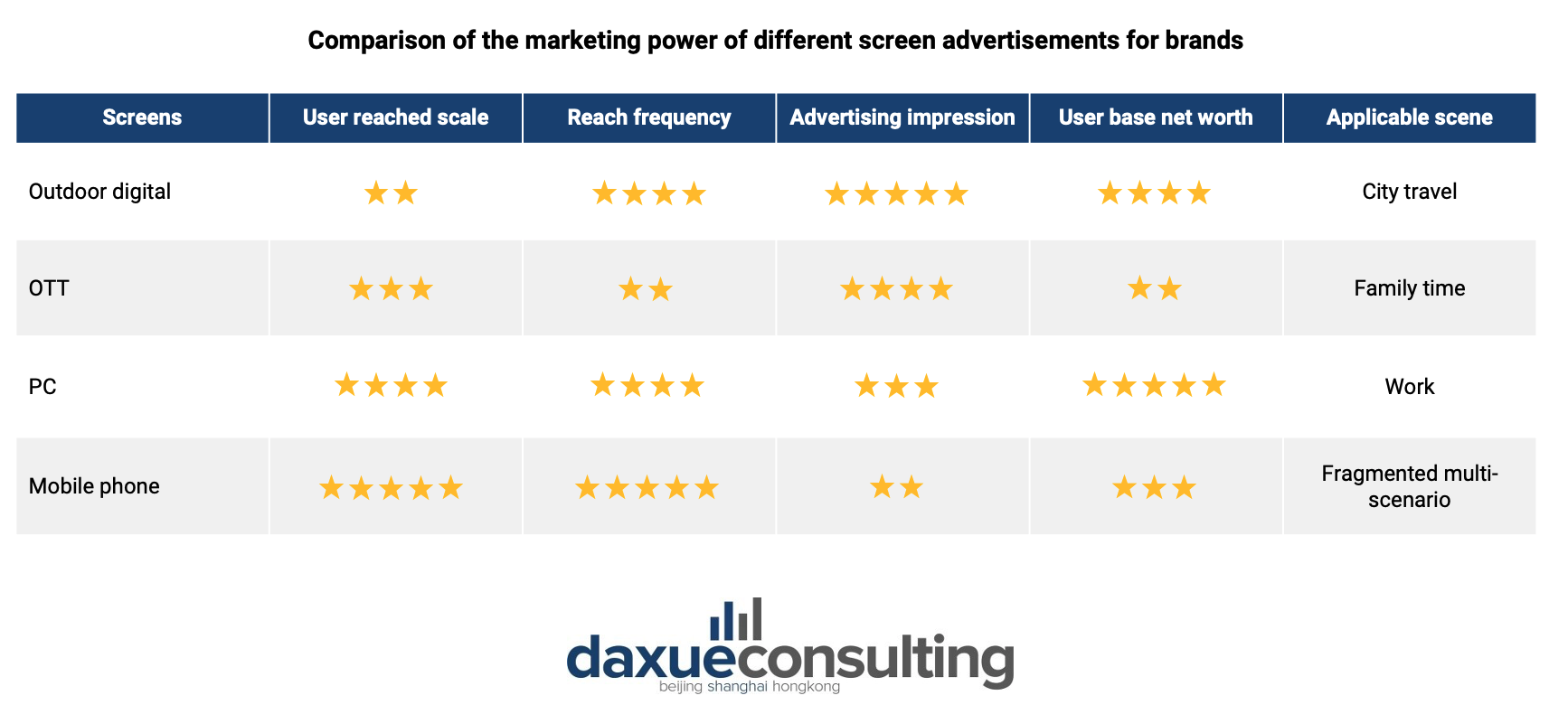
Emotional-centered advertisement strategy and technological advancements are the new trends
Brand-consumer interaction is changing. As the “emotional-centered” strategy is the easiest method to leave an impression on consumers, brands are focusing more on developing and maintaining emotional connections with customers.
The accuracy of brand marketing also has significantly increased because of the empowerment of data and other technology. Emerging technologies like Metaverse have given marketers more creative freedom. Along with this, gradually improving VR/AR technology, deep applications of AI, virtual image IP, and other advancements have opened up new opportunities for businesses to develop innovative commercials.

Media company’s leverage decreased in China’s advertising industry
Each advertisement screen has its own distinct marketing features and typical “scenarios”. Advertisers are now becoming product-oriented instead of media-company-oriented. Brands are now thinking about how to create an efficient advertisement that can enhance interaction and reach the right audience, instead of choosing the right media company.
Guidelines for advertising in China:
- China’s advertising industry is growing at a CAGR of 8.84% (2023-2027). In 2023, the country is estimated to spend US$223.93 billion on advertisements.
- Based on its placement, advertising in China can be categorized into four categories: outdoor digital screens, OTT screens, PC screens, and mobile phone screens. Each placement has its own user reach, frequency reach, and viewer demographics. Thus, brands can adjust their advertising strategy based on their needs and targets.
- With the development of the Internet, consumers are now proactively searching for and sharing information. Choosing the right advertisement strategy —such as ad placement— is essential to achieve the intended results.





